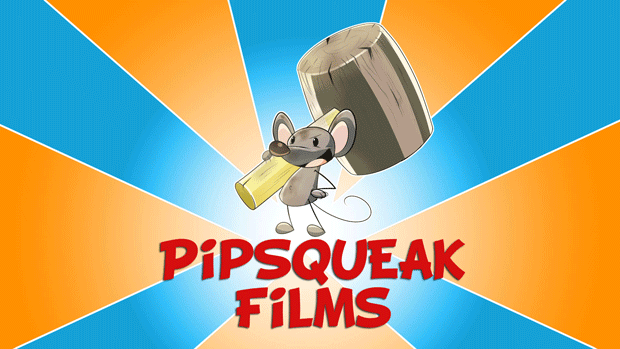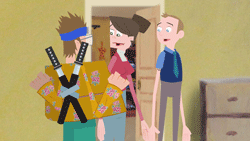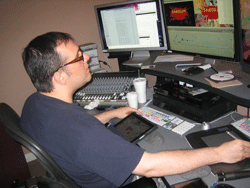 Mike Blum, Founder of Pipsqueak Films is a Writer/Producer/Director of award winning, high end, animated films.
Mike Blum, Founder of Pipsqueak Films is a Writer/Producer/Director of award winning, high end, animated films.
Mike has produced and directed the entire first season of the Emmy nominated original series, “The Adventures of Baxter & McGuire” for Comedy Central’s broadband website.
Mike was the Technical Supervisor for Toy Story 3, oversaw and coordinated all aspects of information technology development and technical process management for the movie.
Also, Mike has been the Software supervisor for internal tool development working on design and deployment of numerous animator-friendly tools used in more than a dozen films ranging from The Hunchback of Notre Dame to Dinosaur to Chicken Little.
Pipsqueak Films, founded in 1996 by Mike is an Emmy Nominated Company with many more honors and recognitions in its kitty.
Currently Pipsqueak Films is out with its latest the 10 X 4 episode animated series, “Samurai! Daycare”, Directed by Mike Blum for Alloy Digital and Shut up Cartoons, this series is aimed at 13-17 year old boys. The series is part of YouTube’s 100 million original content initiatives and a new episode will be aired every Thursday at 2pm for the Next 8 consecutive weeks with the second one to be aired today.
Animationxpress.com’s Zeenia Boatwala recently caught up with Mike on his experience in the Animation Industry, Pipsqueak Films and Samurai! Day Care

Please share about Samurai! Day Care
Earlier this year, we were approached by Alloy Digital about creating content for a new YouTube channel calledShut Up! Cartoons they were starting as part of Google’s 100 Million dollar initiative to bring more professional content to the web. Alloy Digital owns SMOSH which is the third highest subscribed YouTube channel in the world (well over 5 million subscribers) and they wanted to leverage that success into animation. As it turns out, SMOSH was run by Barry Blumberg and some ex-Disney execs I had known for years having pitched and sold material to them some time before. They immediately latched onto my pitch for Samurai! Daycare and quickly green lit the series that chronicles the most inappropriate person in the history of child care. The 10 episode series features a deluded sword-wielding daycare instructor named Ned (Matthew Lillard) who “teaches” a bunch of preschoolers the ways of the Samurai. In addition to Matthew Lillard (The Descendants, Scream, Scooby Doo), this first ever WGA-covered animated web series has attracted a talented cast that includes Bobby Lee (MADtv, Animal Practice) and Cathy Shim (MADtv, Oishi High School Battle).
While we frequently outsource production of our animation work, the economics of the series tilted in favor of keeping the production in Los Angeles. That decision allowed me to work with some old colleagues like Laurent Dareau who hand painted the lush backgrounds and new artists like Joe Apel who came up with the unique anime-inspired character designs and fabulous production design and art direction.
Samurai!DayCare Series Can be Viewed by Clicking on the link below:
What drove you towards animation? We would love to know about how you proceeded with your journey
I’ve loved cartoons since I was very young, especially Bugs Bunny. I was also always fascinated with flipbooks and the idea that individual drawings viewed in rapid succession create the illusion of movement. I became fascinated with computers as a junior high student, and started making my own video games. Later, when I was a senior in college, I took a graduate level computer graphics class and knew I wanted to something in the field as a career. But honestly, even then, I had no idea I would end up actually creating content. It just wasn’t on my radar. I grew up nowhere near Hollywood, didn’t have any mentors or even know anyone who was in the industry, and simply didn’t realize it was even a possibility. Instead, I got my Masters in Computer Science and thought I would pursue a programming career with an eye towards computer animation. After a short detour pursuing money over my core interests, I course corrected and landed a job at Disney Feature Animation creating tools for artists. I had fun doing this for a couple of years but realized that the software group was so separated from production that I didn’t really understand how production worked or how our tools were used. In fact, everyone was so segregated in their own departments, that very few people really understood how to make a movie from beginning to end. So I set up a “training project” as an excuse to learn the animation process and as a result, I made my first short film. My outlook completely changed after that experience. The process of creating something from scratch left me invigorated in a way I hadn’t felt since creating those early video games. But while that first short was fun to make, it honestly wasn’t very good, so I set out to hone my skills by directing more shorts after hours at Disney. The process took years, but I learned a ton not only about filmmaking but also about putting teams of people together and building an efficient pipeline. And my films got much, much better. By the time I made The Zit, I was playing in hundreds of festivals around the world and had landed my first agent. At the same time, I continued to excel at my day job at Disney and eventually moved over to production as one of the leads for what was supposed to be Disney’s first Pixar sequel, Toy Story 3. I was the second hire for the new studio dubbed Circle 7 and was responsible for setting up the studio in preparation for production. This experience proved to be the low point of my career as in hindsight; it seems we were a pawn in a protracted Disney/Pixar battle. Disney wanted to extend their deal with Pixar and Pixar bridled at anyone other than themselves producing sequels of their movies. After a torturous year and a half, Disney purchased Pixar and then immediately handed the animation reins over to them. Two days later, Pixar shuttered our movie and the new studio. But out of those ashes, opportunity reared its head. That week I was offered the opportunity to direct a series for Comedy Central called The Adventures of Baxter & McGuire. And with that I leapt into the great unknown — leaving my cushy job at Disney Feature Animation to start Pipsqueak Films. And I haven’t looked back since. Baxter & McGuire ended up getting nominated for an Emmy, playing in competition at many film festivals including Sundance and Annecy and generating a lot of exciting new opportunities. Since then, in between consulting for animation studios around the world and traveling to speak, we have developed a number of animated series, written two feature film scripts, and have recently branched into live action filmmaking, as well.
 What’s the inspiration behind Samurai! DayCare?
What’s the inspiration behind Samurai! DayCare?
In the case of Samurai! Daycare, my son had been in preschool since he was quite young and I met a lot of wacky parents and teachers during our years in various schools. I thought it would be funny to use that as a starting point for a series. And I watched so many Hong Kong martial arts films as a kid; I thought it would be highly entertaining to put an outsized personality of a Samurai! in a tiny setting like a daycare. Ned, our main character, is a bull in china shop.
When did you start working on the series? How much time has it taken to complete Samurai! DayCare?
We signed the contracts in February, were writing scripts, landing our talent and in preproduction through April and then cranked through all of animation in just over 8 weeks in May and June. Episodes were animated in 3 days each. Most of our post
Production was finished in July this year.
What is the prime key to create memorable animation and what concepts are your personal favorites?
Making any film (animation included) is an amalgamation of 10,000 decisions so you want to try to make as many good decisions as possible. To do so, I iterate on every element of the project for as long as our schedule allows. From scripts to character designs, art direction and animation all the way down to sound fx and mix, I’ll refuse to give in until we’ve squeezed all of the juice out. I’m also open to constantly seeking criticism to test my ideas. Animation is not a one man show and I believe my job as a director is to filter the input of trusted colleagues through my creative vision. I have pretty diverse tastes so I have everything from animated preschool shows to adult-centric, hybrid features (live action/CG combination) in development.
The research for Samurai! Daycare must be pretty extensive, isn’t it?
Well, I certainly had a lot of fun revisiting my favorite martial arts films from childhood. And I doled out clips to my writers so that we were all on the same page tonally. In terms of research on Samurai! DayCare themselves we did do quite a bit, but part of the fun of the show is to figure out what is real and what Ned simply made up. Ned is the kind of guy that thinks he knows more than he actually does. There are many running gags through the series of Ned lumping all things “Asian” into one category. So even though Samurai are from Japan, Ned refuses to accept that the Korean grocer Park isn’t his sensei. And the series is sprinkled with many Samurai quotes. Some of them are real and some aren’t. In fact, some of the more ridiculous quotes are the real ones!
 The Pre Production?
The Pre Production?
As with the rest of the series, pre-production was very tight. We were very ambitious in terms of the number of characters, backgrounds and props that needed to be designed and both Joe Apel and Laurent Dareau did amazing work in limited time. We easily had as many characters and props as a network or cable show with just a fraction of the budget.
I would like to know more about the voices for Samurai! Daycare
We had an amazingly talented cast. First, we were fortunate enough to land some star talent. Matthew Lillard (The Descendants, Scream, Scooby Doo) is our Ned and he blends overconfidence and nerd perfectly. Bobby Lee (MADtv, The Dictator, Animal Practice) is hysterical as Park. I really wanted to cast a Korean comedian for the role and Bobby Lee is about as big as we could get. Cathy Shim is our final lead, Jess. She is an amazingly talented actress and comedian, who appeared in tons of TV shows like Reno 911, MADtv and Balls of Fury. The rest of the cast is made up of supremely talented pros, which do tons of VO work for animation, video games and commercials in addition to their acting careers. Dino Andrade plays several characters in the series and is probably best known as The Scarecrow in Batman: Arkham Asylum. Other actors include Ashley Adler, Chris Ciulla (a hysterical MMA wrestler in episode 10), Eric Schwartz (a prominent comedian), golden voiced Christopher Smith, Joe Sanfellipo, and certainly not least my own son, Rohan, who voices all the little boys in the series.
Can you give us in depth knowledge about the Production of Samurai! Daycare?
As with all animation, we recorded our dialogue first and cut our radio plays to time before we even began the boarding process. In order to streamline boarding, we boarded in Flash so that when we went back to editorial, we were already 80% of the way there with our animatic. This saved a tremendous amount of work, although Sharon Colman Graham, our Academy Award nominated board artist might disagree with that assessment! While we were boarding, we showed cuts to our animators so that they could add input as to what was possible or too ambitious to achieve given our schedule. This feedback loop helped to simplify the boards tremendously.
While we were boarding, Sharon fed rough layouts to Laurent, our background artist, so that he could paint all the elements we needed. We intentionally painted large, over scanned artwork so that we could use different portions of the backgrounds for variety. While Laurent is proficient with Photoshop, he is a very fast fine artist and he chose to hand paint each background with oils as a way to save time. I know, hard to believe! I think this lends a really rich, painterly look to the series and goes a long way to upping the production value at no extra cost. Once we had our locked animatic, we cut it up into individual shots. These broken up pieces of video became one of the elements in the Flash files we created for each shot and served as a firm guide for our animators. Our interns set up each shot file to contain all the assets the animators needed to work: background, rigged characters, props, and camera.
At this point, the animators, Joe Apel, Ramiro Olmos and Randy Sanchez, could fly through their work, averaging 25 seconds of animation per day per animator. In order to keep the whole pipeline streamlined, we did almost no compositing. Everything was loaded in the Flash scene file and any matting or efx work that needed to be done was done right in Flash. While this might seem like a limitation, eliminating a step in the pipeline was critical in making our schedule and I rarely felt like I compromised in terms of the visuals.
 And how about Post Production
And how about Post Production
For Samurai! Day Care, we wrote swf files out of Flash and then used After Effects to render tiff files that we passed to our editor. Our editor only saw final frames. Any intermediary editing we needed in order to check continuity was done with Windows Media Player or with Adobe Premiere. Our editor, Joe Gressis, edited with Final Cut but he would occasionally pop into Avid to confirm shots, grade footage or do other post effects like the wavy effect that takes us into “Samurai! Vision”. Sound design and mix was done with ProTools.
What is the most happening/attractive aspect of Samurai! Daycare? Why would you recommend it to the audience?
First and foremost, my writers and I worked very hard to create a comedy with a full three act structure so that you feel like you have seen a complete story unfold in each bite sized nugget. And the humor is a mix of high and low brow in equal measure. For every piece of clever word play or sly reference there is a bodily function joke or piece of sexual innuendo. Nothing crosses the line into adults-only territory, but I don’t know that my 5-year-old will be able to watch much of it for several years.
Whats the most challenging part in developing Samurai! Daycare
It was a challenge trying to develop crisp characters and stories that could be told in a scant few minutes. It required harshly cutting away all extraneous fat and brutally examining every word.
What are the future plans of Pipsqueak Films?
In terms of the future, we have been asked to produce a couple of small pieces for clients in the immediate future but I’m unable to speak about them until the end of September. We are also prepping our first feature script, Below, which we hope to take out this fall. Belowasks the question “what if not every dinosaur met a cataclysmic end when a fiery asteroid collided with Earth 65 million years ago? What if a lucky few burrowed deep underground to escape the devastation, and over the eons evolved, developing speech, written language, and advanced technology long before man first walked the earth?” We are also prepping an animated, comedy series that I am really excited about but unfortunately can’t talk too much about yet. It’s very high concept and combines two of the most popular genres going today in a very twisted way.
